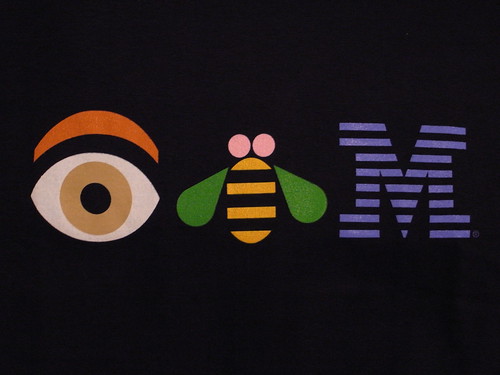The motif of the eye, and the importance of seeing, recurs throughout Blade Runner. From the opening shot of the future city reflected in the eye, to the Voight-Kampff machine, to Roy's final speech of a life experienced through the act of seeing, the gaze and the eye are everywhere.
Even Dr Tyrell's glasses are huge and distorting- the creator has exaggerated eyes and the creations- the Replicants- can be determined as non-human through the reactions of their eyes.
When Roy finally destroys his creator (with shades of Frankenstein,Freud and Nietzsche- creator, father, God), he pushes his thumbs through Tyrell's eyes, the same method we see foreshadowed when Leon attacks Deckard.
Rachel's outward appearance alters once she and Deckard sleep together. From the icily beautiful to a very human natural unconstructed look, her appearance is the signifier of her humanity. The icily beautiful a signifier of her perceived humanity, the unconstructed natural appearance a signifier of her newly found humanity.
See The Eyes Tell All A What, Where, Why Commentary of the Bladerunner Theme John McCoy
Friday, 28 October 2011
Play, Animation and Bla Bla
Bla Bla, created/directed by Vincent Morisset is a strange creature. It isn't an animation, or a game, but something that subtly uses elements of both. There is no defined narrative, but a series of interactions between the viewer/player and the animation. The actions offered to the viewer/player are limited, but produce a sense of playfulness, interaction and
discovery.
“The youngest kids navigated their way through BLA BLA easily, without any guidance. An adult who doesn’t have a strong grasp of interactivity might find themselves clicking the same spot over and over, missing all kinds of possibilities.” Morisset adds, “There’s an element of culture in all this. Younger people understand the principles of interactivity, and they know what to do.”
Produced for the National Film Board of Canada, Morisset calls the work a "film for computer".
Here is an interview with Morisset.
You can watch/play Bla Bla here.
The Gaze
Here's an image from Think Eye Tracking Market Research Blog,
"In 1967 Yarbus eye tracked people viewing the painting “They did not expect him” by Repin. The instructions given to the participants varied from, among other, free examination, to the people’s ages, and how long the visitor had been away."
"In 1967 Yarbus eye tracked people viewing the painting “They did not expect him” by Repin. The instructions given to the participants varied from, among other, free examination, to the people’s ages, and how long the visitor had been away."
Wednesday, 19 October 2011
Barbara Jones
Barbara Jones curated the'Black Eyes & Lemonade" exhibition in 1951. Whilst looking for images of the exhibition I found this image of her work for a 1969 exhibition in a long-closed spaceship science museum in the Netherlands, Evoluon.
It's called "Man's Perceptions".
It's called "Man's Perceptions".
Here's a really interesting promotional film for the exhibition, with a quick view of Jones' work at the end. The concepts of design, aesthetics, science and play all seem to come together really well throughout the film of the exhibition. And the soundtrack is lovely.
The Magpie "I" & The Wellcome Collection




The object is transformed through the process of collection.
The Wellcome Collection is a stunning. Drawn from the collection of Henry Wellcome, the co-founder of a pharmaceutical company, the (mainly) medical related exhibits are often shown in curated events, with simple titles such as Skin or Dirt.
The direction of the curation creates new contexts within which to see the objects.
The direction of the curation creates new contexts within which to see the objects.
Play
"There can be no play without rules." Paul Rand



"Dare to be naïve."
Buckminster Fuller, Synergetics: Explorations in the Geometry of Thinking (1975)

Being playful (in the context of illustration or other artistic process) would seem to be based on the ability to be inventive, disengaging the rational mind and allowing the childlike, creative mind to spur itself onwards, like a self-propelling contraption. In this altered state, the mind can make leaps and connections which the rational mind may struggle with. By removing the "Why?" from the process, all things are possible. The meaning and language of symbols can become more fluid and perception of ideas can become more abstract. It's the rules of play which Paul Rand mentions which allow the actual creation of an artwork to occur. They allow a route out from this creative state into the real world.
Mummers
These rough, strange creations- part folklore, part nightmare- remind me of Commedia dell'Arte, with the preset, stock characters filtered through local interpretations. It's not just the fact that they are masked that makes them appear uncanny, it's the sense of a community together in an altered state.






Tuesday, 18 October 2011
Klimowski
“I see the illustrator as a transmitter,” he writes, “one that receives messages and transforms them into images.”





Subscribe to:
Posts (Atom)







